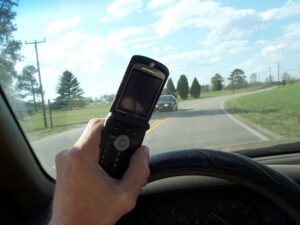Distracted Driving and the Strains on Our Brains
What do we think about when we hear the phrase “distracted driving”?
Texting, talking on a cell phone, e-mailing…all while driving?
This morning, while traveling Florida’s turnpike, I happened to look over to see a man in a SUV; with a cup of coffee on the dash, a newspaper draped over the dash and a razor in his right hand – all while traveling along at 70 mph. The disturbing part was that the man was in the driver’s seat of the SUV.
Distracted driving includes a whole bushel basket of things that drivers have been doing for a very long time, but only since we have been able to talk on the phone and text while driving have we been giving any considerable thought to the very real dangers they present.
Distracted driving may have begun before, but certainly it came into full being when the first radio was placed in the first car. For the first time, drivers had something in their vehicle that represented entertainment and a distraction from their driving. Or, was the first distraction a cigarette or a cigar; a passenger; or simply the first speedometer? All of these things represented “innocent distractions” from driving that no one really thought a great deal about until we introduced whole offices and entertainment centers into our automobiles.
Today, we have distractions from many, many sources, including (sadly not limited to):
|
The National Highway Transportation Safety Administration (NHTSA) reports that over 453,000 people were injured or killed on our nation’s roadways in 2009. This number included some amount of potentially avoidable deaths (5,474 in total); if we simply reduced or eliminated the use of cell phones in vehicles.
Distractions are no longer limited to the standard two types: visual and cognitive, when driving a car or other vehicle. A third type of distraction added to the dangerous mix is the manual demands of both driving the automobile or truck and completing distracted tasks. Similarly, distractions are evaluated based upon three critical reasoning categories:
Internal distraction — a situation requiring a response because his/her attention is directed to some event, object, person, or activity inside the vehicle. Relevant examples include tuning the radio, adjusting the heat/cooling system, engaging in a conversation with a passenger, using a cell phone, retrieving fallen objects, reading books/magazines/maps/invoices, etc.
External distraction – crashes in which the driver fails to recognize a situation requiring a response because his/her attention is directed to some event, object, person, or activity outside the vehicle. Relevant examples include searching for a street address, construction activity, looking at a building or scenery, looking at a sign, looking at a previous crash site, etc. Distractions are distinguished from inattention in that distractions induce the driver to focus attention on the distraction.
Inattention distraction — when the driver fails to recognize a situation that demands a response because his/her attention has wandered from the driving task for some non-compelling reason. In this circumstance, the driver is typically focusing on internal thoughts (i.e., daydreaming, problem-solving, worrying about family problem, etc.) and not focusing attention on the driving task.
What may also be added to these categories are the very unique mechanical “distractions” created by using certain devices in a certain way. For example, holding a cell phone to your ear requires you to change your field of vision, either slightly or substantially, it requires you to move your arm and hold it to your ear, and it requires you to limit your ability to move due to positioning. All of these things may seem minor, but collectively, you have demanded that your brain process 5 or more additional thought processes in addition to those already being demanded from driving. Studies have demonstrated (Angell, et al, 2006; Harbluk, Noy, et al, 2007) that seemingly minor tasks, such as holding and talking on a cell phone, impact driving attention significantly:
- Limiting visual scanning
- Limiting field of vision
- Neglecting peripheral vision demands
- Negative impact on processing roadway information
It seems pretty clear that the demands of operating a two ton vehicle all by themselves require as much mechanical freedom and mental processing as our brains are capable of delivering safely. Each task you add to your “built-in driving distractions simply adds to your error potential and increases the likelihood of an accident.
Share This



